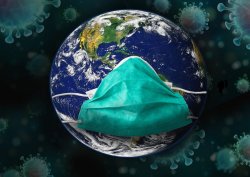
by Thom Hartmann
May 28, 2020
 Every advanced democracy in the world has its coronavirus epidemic largely under control except the United States. And we’re on the verge of melting down again because a substantial minority of Americans simply don’t know the basic science of how an epidemic works and why wearing masks is part of breaking the epidemic chain.
Every advanced democracy in the world has its coronavirus epidemic largely under control except the United States. And we’re on the verge of melting down again because a substantial minority of Americans simply don’t know the basic science of how an epidemic works and why wearing masks is part of breaking the epidemic chain.
Hopefully, you can help your Trumpy friends understand, by sharing this short article with them.
A popular way to understand how a virus can appear to “suddenly” explode into a local epidemic is the example of a pond and a lily pad.
On day one, the pond is clear of vegetation and somebody puts a single lily pad plant into it—one that doubles every day. By the 30th day, the pond is entirely covered with lily pads and you can’t see the water.
The question that’s key to understanding what this has to do with COVID-19 is: “On what day was the pond half-covered by lily pads?”
People who don’t know science would say that it’s probably halfway through the 30 days—day 15, or sometime around then, maybe day 20.
But the correct answer is day 29, the day before “half-covered” doubles and becomes “fully covered.”
Similarly, the day when the pond was one-quarter covered was day 28—two days before it was entirely covered. It was one-eighth covered (far less worrisome) on day 27, three days before it was entirely covered.
Although it may take more than just one day for COVID-19 incidents to double, this explains why one day it seems like there are just a few cases and within a week or two hospitals are “suddenly” overwhelmed, and unthinkable numbers of people are gasping for air and dying.
Once you wrap your head around that example of exponential growth or geometric progression, consider the formula in reverse.
If you can interrupt the process of doubling just one day earlier, you can keep half of the pond from being covered. If you interrupt it two days earlier, only a quarter is covered, and so forth. This is why researchers recently concluded that if Trump had locked down the country just two weeks earlier, 54,000 people who are now dead would still be alive.
While the COVID-19 virus is highly contagious, the thing we’ve learned from outbreaks in meatpacking and food processing plants, nursing homes and prisons is that close, unmasked proximity to an infected person and the time spent with that person in close contact (and, particularly, discussion or singing) are crucial to converting a small contagion into an explosive local epidemic.
The thing we’ve learned from church choirs and services where people sing together is that aerosolized droplets from only one or two infected persons talking or singing loudly travel a substantial distance and can infect many of the people in their proximity.
And we know from more than 100 years of studies on hygiene and disease transmission during surgery that a simple surgical or cloth mask—while it won’t do as much to protect the person wearing it from being infected by others—will work very, very well to protect everybody else from the infected person talking, singing or even breathing. That’s why a surgeon wears one—so their own breath won’t infect an open wound in their patient.
Thus, the majority of the work to convert an epidemic outbreak into a simple localized pocket of infection is for everybody to wear masks, to minimize our time around others indoors, and to test asymptomatic people and isolate those who are infected and didn’t realize it.
Recently, my wife Louise and I drove by several parts of Vancouver, Washington, including a few newly opened restaurants and an outdoor farmer’s market. Fewer than half, and in some places fewer than a fifth of the people we saw were wearing masks; in most cases, people weren’t social distancing.
While the great axiom of politics is that power in a democracy drives from the bottom up, and that’s certainly true of activism, the simple reality is that in both business and politics leadership comes from the top down.
Places like Hong Kong (4 total deaths), Taiwan (7 total deaths), New Zealand (21 total deaths) and Australia (103 total deaths) have leaders who socially distance, encourage masks in public and clearly explain to their citizens that everybody needs to wear a mask not for themselves but for those around them. They typically describe wearing masks in public as simple good manners.
Tragically, here in the United States (more than 100,000 dead) we have no such leadership; instead, Trump is providing anti-leadership by refusing to wear a mask in public (during press conferences, factory visits, and more) and encouraging disease-spreading behavior—such as tweeting his support of Michigan protesters who bore Nazi symbols and Confederate flags as they refused to wear masks and ignored social distancing rules.
When you talk with folks who get their news from Fox or right-wing hate radio, you discover that most of them believe mask-wearing and social-distancing are measures intended primarily to protect the individual wearing the mask or keeping their distance. Because they’re convinced COVID-19 is just a bad flu (a myth spread by Trump) that only kills old people and black people (wrong again), they don’t believe they need to wear a mask or stay back from others because they don’t need the protection.
But those who don’t wear masks or follow social distance advisories in the name of “freedom” end up being the most likely to be infected and thus infectious to others because their mistaken understanding encourages them to participate in risky group and interpersonal behavior.
We’re literally the only developed country in the world where large minorities of the citizens don’t understand the simple science of social distancing and mask-wearing and haven’t been told conclusively by the nation’s leaders that both are something to do as a sign of respect and concern for others far more than for yourself.
A person in Taiwan or New Zealand refusing to wear a mask or social distance would instantly be seen by pretty much everybody around them as an inconsiderate, narcissistic ass; here, these people think they’re proclaiming their love of “freedom.” (Although I’d bet most of them still wear seatbelts in cars and planes; go figure.)
Professor Mikihito Tanaka of Waseda University, who spoke with the media on behalf of Japan’s expert panel on COVID-19, points out that even though Japan didn’t totally lock down, they were still able to keep infections and deaths below any other G7 countries.
Professor Tanaka said, “We have found out that wearing masks, hand hygiene, physical distancing and avoiding talking loudly are effective in preventing transmission.”
Trump wants America opened back up and money again flowing to the nation’s corporations and billionaires. If he’d simply encourage mask-wearing and social distancing, mandate and fund widespread testing and contact tracing, and help the federal government communicate why taking these precautions is necessary to all Americans, he may be quite a bit of the way toward an “open America” by this fall.
Those simple steps can slow disease transmission to a level where it’s an annoyance to society and business (and a tragedy to those who die) but not a local epidemic event that necessarily forces businesses to close again.
But his phony macho has shot him in the foot.
Maybe he’ll figure it out when the second wave becomes evident through the rest of the summer and early fall. But by then, it’ll be too late to save the economy; we’ll have slid back into the Trump Depression just in time for election day.



